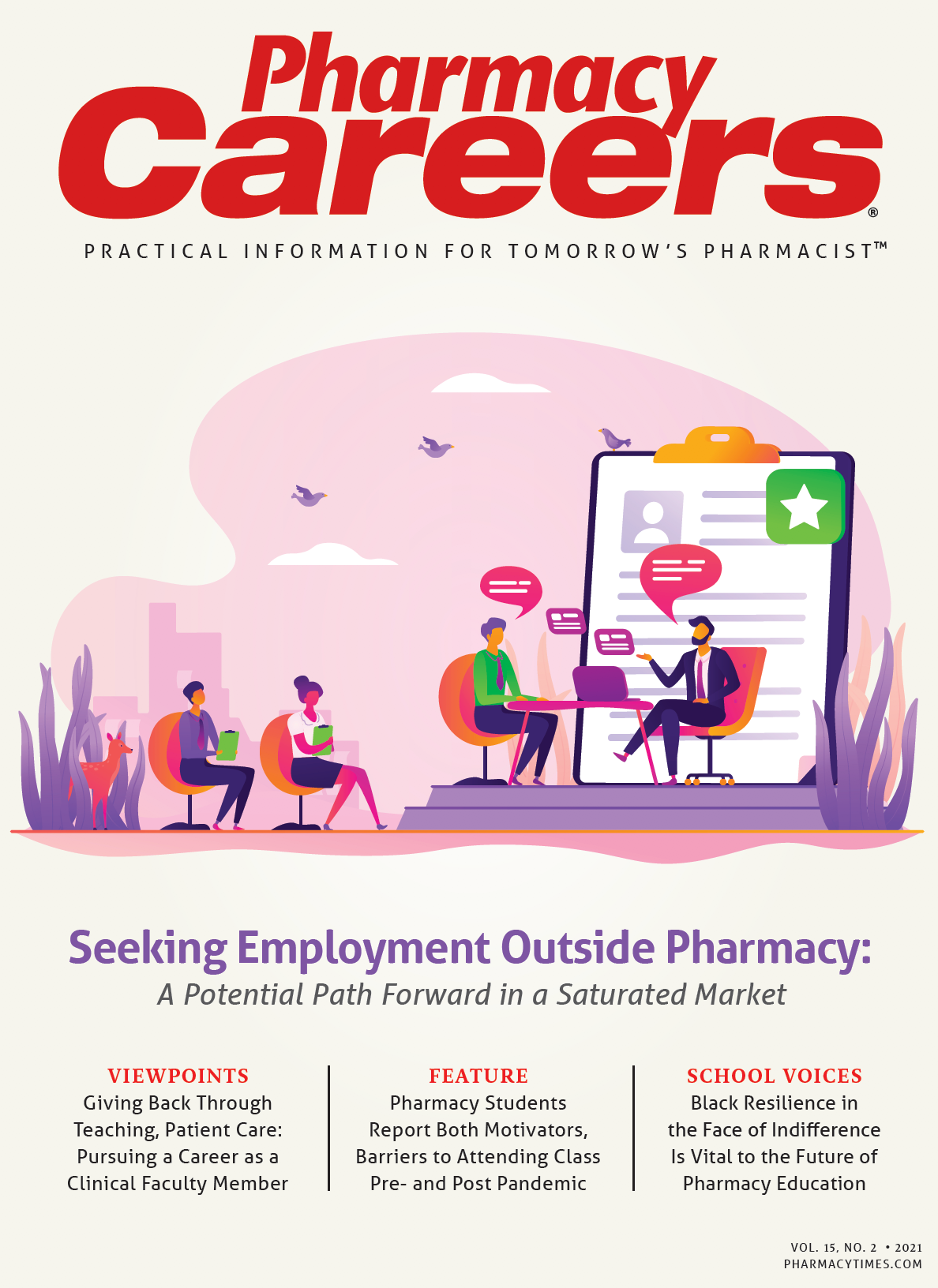Publication
Article
Pharmacy Careers
Pharmacy Students Report Both Motivators, Barriers to Attending Class Pre-, Post-Pandemic
Author(s):
At the University of Texas at Austin College of Pharmacy, pharmacy students in academic years 1 through 3 face several barriers that hinder their motivation or ability to attend class. However, new technologies may provide novel learning opportunities to address these barriers.
With the introduction of a wider range of technology in classrooms, such as online access to recorded lectures, some experts have questioned whether these advances can hinder students’ attendance and grade point averages (GPAs). This idea has been confirmed by a study of students in the Master of Pharmacy program at the Ulster University School of Pharmacy and Pharmaceutical Sciences. In this study, investigators observed that courses in which students were provided with recorded lectures had statistically significant rates of lower attendance.1
On the other side of the debate, advocates argue that providing students with resources such as online recorded lectures can provide a more learner-centered environment that can better appeal to students with dual-learning styles.2 This tailored approach has shown positive feedback on “student’s exam performance or on their learning, in general,” accord- ing to the investigators. They also credited recorded lectures with “helping [students] study more efficiently.”2
These seemingly contradictory findings pose the question: How important is student attendance when the end goal is mastery of the material? The emergence of the COVID-19 pandemic has reinvigorated the debate around this point, creating interesting and challenging circumstances for students and educators alike.
I studied this question in my honors program thesis in which I aimed to address the various complexities of student motivation, engagement, and attendance in relation to mastery of course material. My paper also touched on the impact COVID-19 has had on student engagement and understanding while learning remotely.
I used a qualitative mixed-method research approach to examine the major barriers and motivating factors.
The study was initiated in the fall of 2019 with a recruitment email containing the survey link that was sent to all enrolled student pharmacists in the PharmD program at The University of Texas at Austin College of Pharmacy. Following this email, a snowball sampling technique was utilized to recruit participants for the interviews. Additionally, voluntary semi-structured interviews were conducted in the fall of 2020 to obtain students’ rationales for their survey responses.
The survey reached approximately 400 pharmacy students, 62 (15.5%) of whom completed it. Figure 1 shows a breakdown of participants by various characteristics. Respondents rated various motivators and barriers on a scale of 1 to 5, in which 1 was the most discouraging barrier and 5 was the most encouraging motivator.
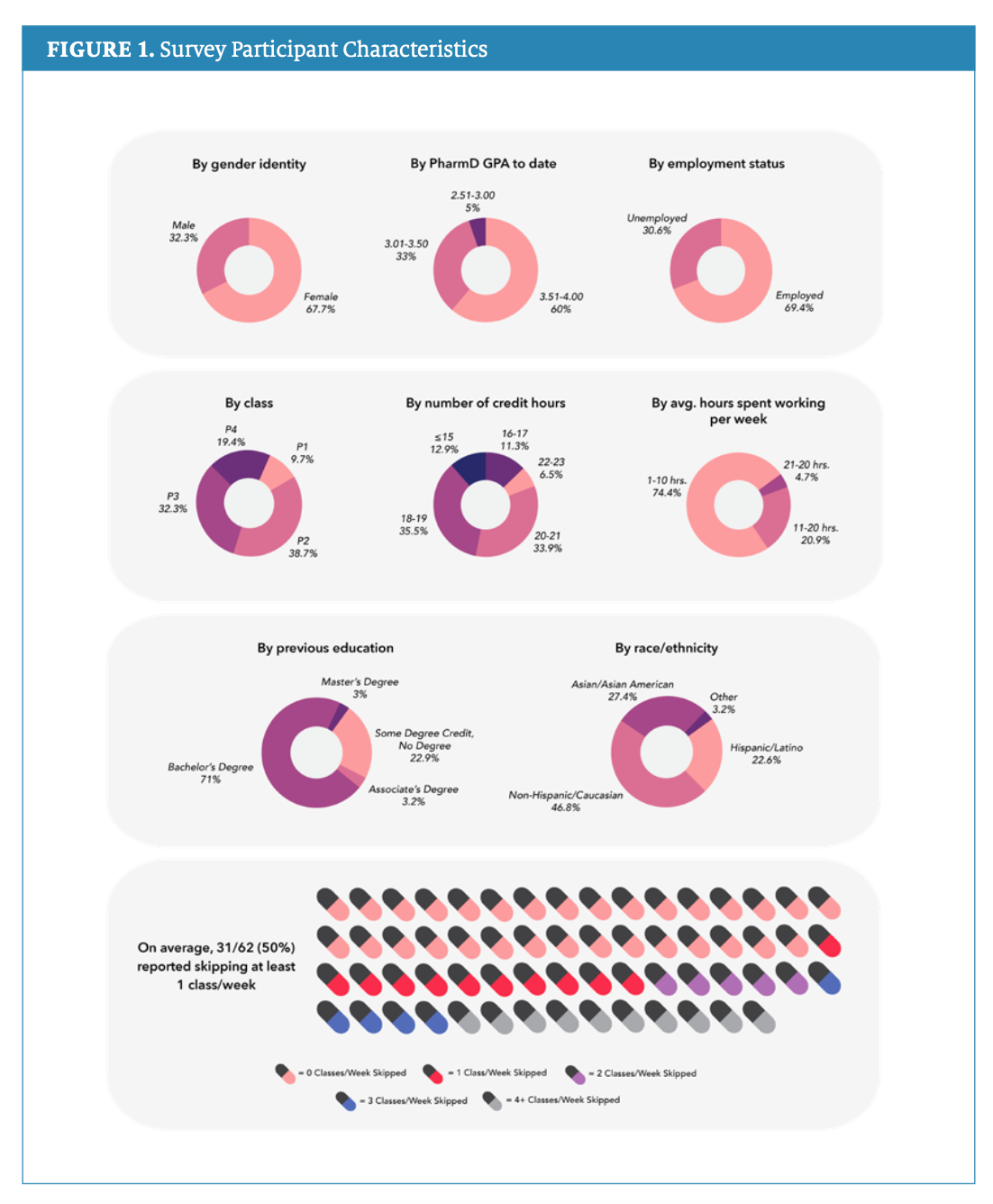
The survey results found that the largest motivating factor to attend class was the instructor’s teaching style, with an average rating of 4.52 out of 5. The most discouraging barrier was participants’ work schedules, with an average rating of 2.84 out of 5. Mental health, unfinished course work, lack of sleep, the commute to class, the amount of lecture material being tested, and parking were also mentioned. Figure 2 shows the Likert scale results, with 1 indicating a perceived barrier and 5 indicating a motivator.
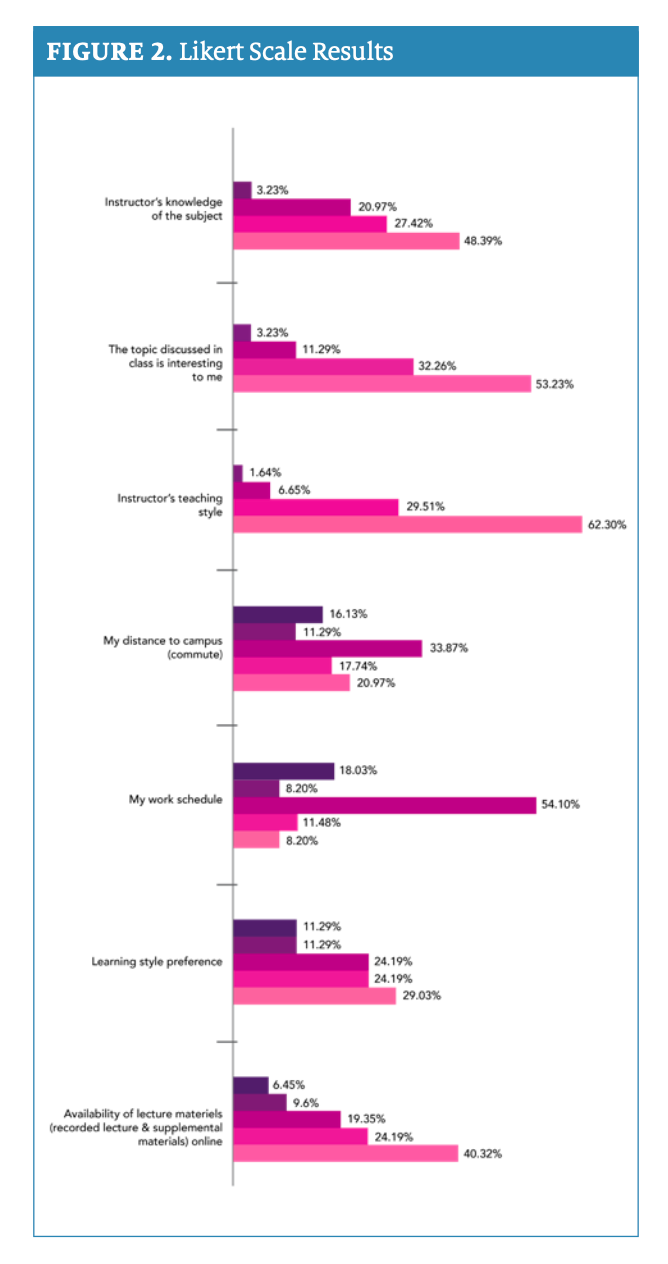
Interviews were conducted with 15 volunteers, or 24% of the total survey respondents. Table 1 visualizes codes and their respective frequencies, with higher code application counts indicating stronger significance. Table 2 represents larger themes and their respective codes, calculated based on greater numbers of code applications.
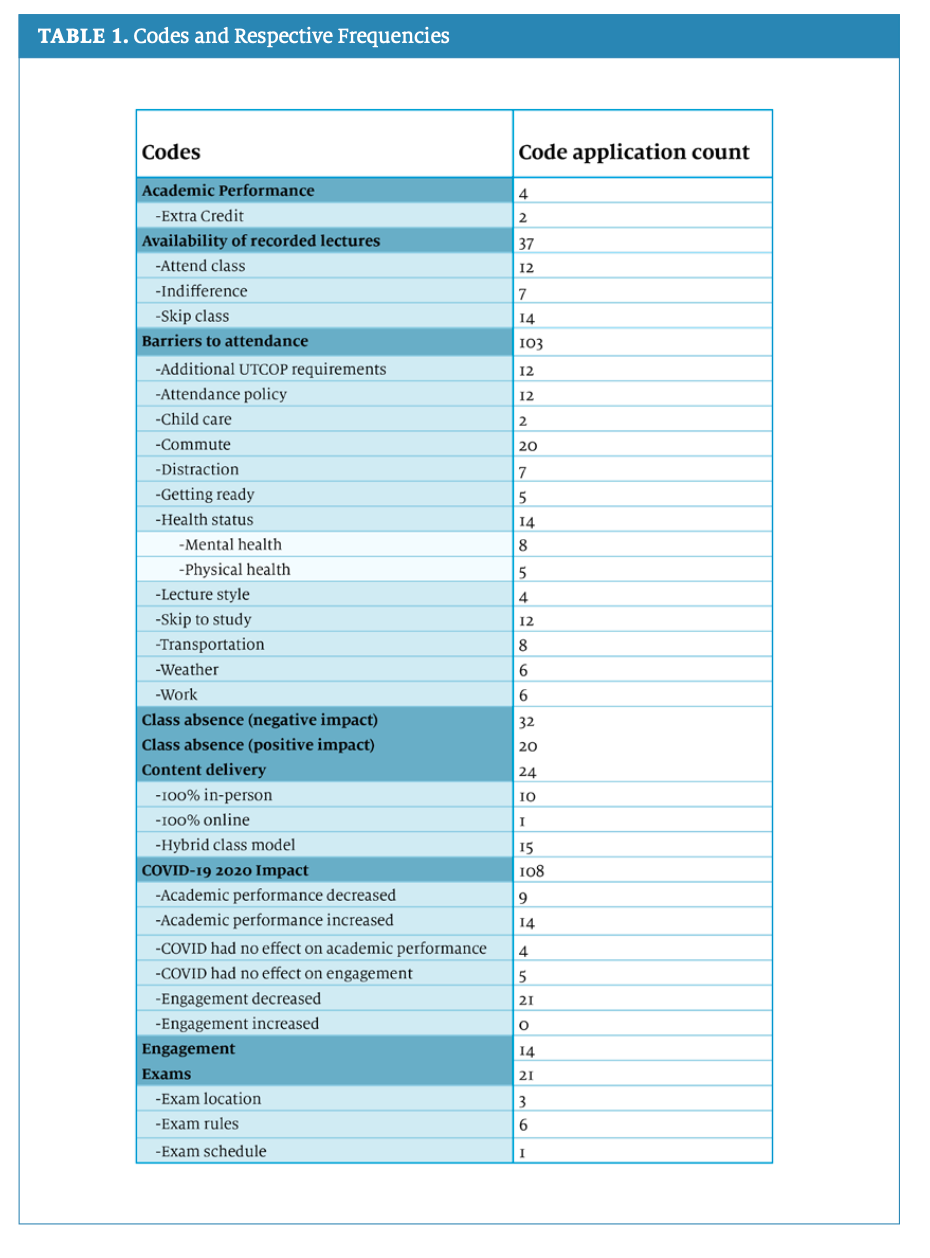
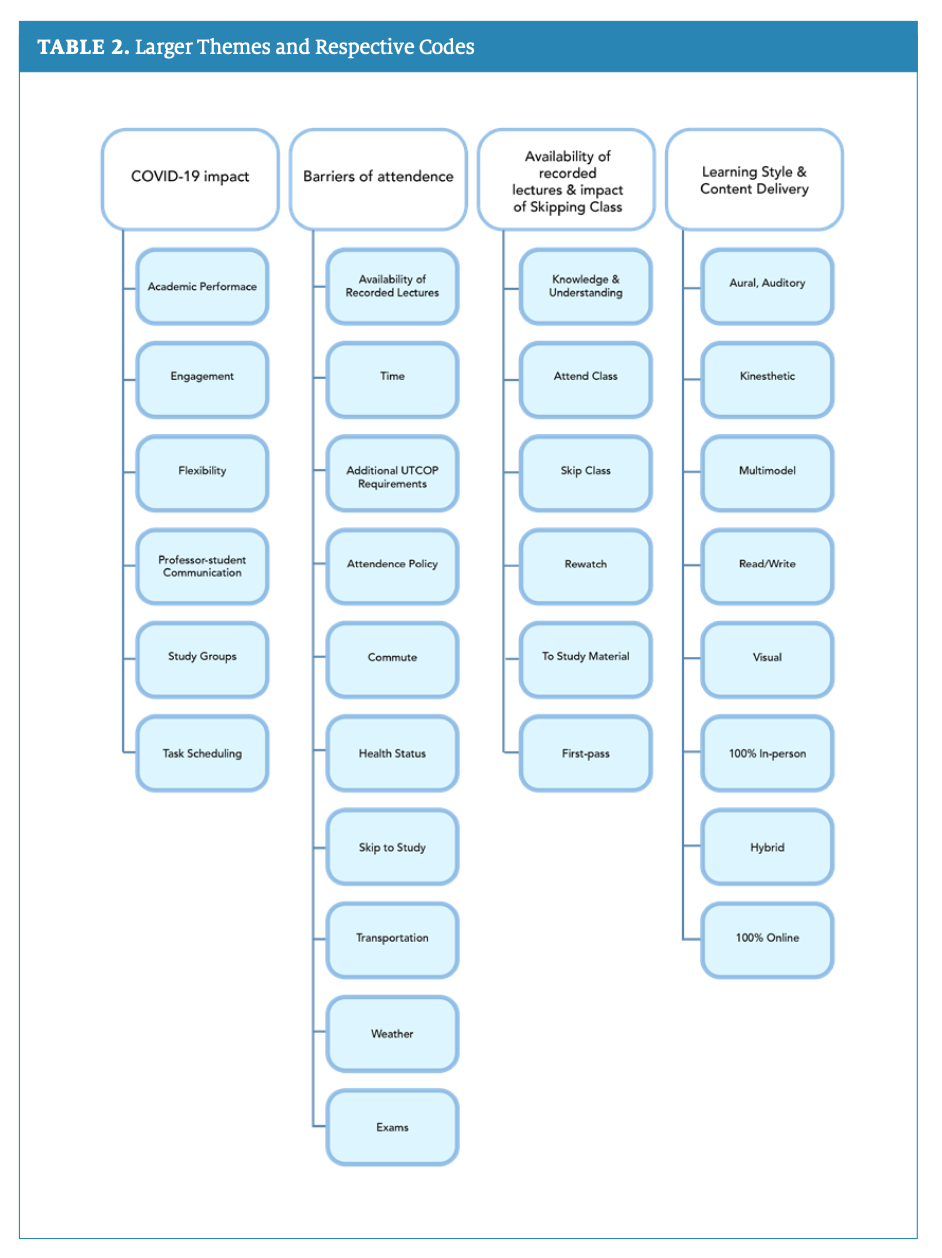
Based on the results, the study shows that pharmacy students will take initiative to balance and prioritize their specific work, school, and life needs. Students understand the consequences of skipping classes, which can result in falling behind in the material to a point where grades may suffer.
So why do students continue to skip classes? The availability of recorded lectures might objectively make a student more likely to skip an in-person or synchronous class, but a student’s academic success in that class is maintained by interacting with course materials and using methods that better align to the student’s learning style. Therefore in-class attendance is not mandatory to achieve success in a course because students are able to engage, ask questions, and learn the content in other ways.
Instructors should not be discouraged by these findings. A large majority of students interviewed said they made great efforts to attend their classes and noted experiencing benefits to attending classes in-person. Those students who reported that they were able to successfully attend class regularly said they do so because in-person attendance is how they best learn and engage with the material.
One way to potentially navigate this new information is to meet students where they are, in terms of their learning styles; this method can increase engagement and academic success in any course. In application, this may entail expanding instructor lecture styles in the in-person class setting to encompass more time-flexible and interactive or conversational activities, which can help facilitate learning based on the learning style of a student in class rather than outside of class.
Most interviewees reported that the COVID-19 pandemic and the resulting implementation of online-only classes drastically decreased their engagement in the course material while also resulting in mixed effects on academic performance. During the interviews, students either reported increased academic performance or decreased academic performance, suggesting that some students could still effectively learn in a virtual classroom setting. Those with learning styles that can harmonize with virtual content delivery were successful while students who best learn through in-person content delivery struggled.
During the COVID-19 pandemic, many unique efforts were made by the college, faculty, and students to address areas of need experienced by students while learning in a virtual environment. Students’ perception of successful efforts included flexibility and understanding, transparent professor-student communication, virtual study groups, and task scheduling, such as blocking time using calendars or planners.
In addition to the impacts on students’ academic careers, there has been debate regarding the lasting impacts of COVID-19 on physical places in which people work—with some positions that were historically in-person being permanently conducted online from home. Educators and students are not immune to this circulating theory. Because virtual learning is likely to remain—to some degree—once the world recovers from the COVID-19 pandemic, implementing a hybrid class model could potentially produce positive results for students, such as alleviating the time and commute burden that some students struggle with.
Based on the study findings, the data demonstrated that routinely skipping class did not generally have a negative impact on students’ mastery of course material, as evidenced by self-reported GPAs. Additionally, the benefits of recorded lectures were shown to outweigh the consequences of skipping in-person classes as they provide students with more opportunities to engage with the course material. Looking to the future, better tailoring lectures to student’s learning styles may help to facilitate academia’s successful transition into the now pervasive hybrid learning model.
Cara Rutledge is a 2022 PharmD candidate at The University of Texas at Austin College of Pharmacy.
References
1. Irwin N, Burnett KM, McCarron PA. Association between attendance and overall academic performance on a module within a professional pharmacy degree. Curr Pharm Teach Learn. 2018;10(3):396-401. doi:10.1016/j. cptl.2017.11.008
2. Traphagan T, Kucsera, JV, Kishi K. (2010). Impact of class lecture webcasting on attendance and learning. Educ Technol Res Dev. 2010;58(1):19-37.
